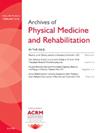体外冲击波联合富血小板血浆和运动治疗外上髁炎的临床疗效:前瞻性随机假对照超声研究。
IF 3.7
2区 医学
Q1 REHABILITATION
Archives of physical medicine and rehabilitation
Pub Date : 2025-08-01
DOI:10.1016/j.apmr.2025.01.420
引用次数: 0
摘要
目的:评估两种不同的再生疗法,体外冲击波疗法(ESWT)和富血小板血浆疗法(PRP),以及治疗性运动对外上髁炎(LE)患者的联合疗效。设计:前瞻性、随机、假对照试验。设置:门诊。研究对象:91例LE患者病程为bbbb3个月,随机分为3组。干预措施:参与者被分为PRP+ESWT、假PRP+ESWT或仅ESWT治疗组。各组均接受运动治疗。主要观察指标:主要观察指标为VAS疼痛评分。次要结果包括握力、患者评定的网球肘评估(PRTEE)、手臂、肩膀和手的快速残疾(Quick DASH)、短表36 (SF-36)、超声评估(普通伸肌腱[CET]测量和超声总评分[TUSS])和等速评估。参与者进行了三次评估:治疗前(T0)、4周后(T1)和12周后(T2)。结果:在随访时,PRP组在VAS(活动和夜间)评分方面优于其他组。至于次要结局,在短期内,PRP组在prtee功能上表现出具有统计学意义的差异。在第12周,PRP仅在所有PRTEE参数上优于ESWT,并且在Quick DASH得分上也优于其他组。在握力方面,PRP组在T1时优于Sham PRP组,在T2时优于两组。在等速评估中,PRP组在随访期间腕关节屈伸峰值扭矩得分均优于Sham PRP组。在第4周和第12周,两组间的超声参数(包括CET厚度和TUSS评分)均无显著差异。结论:ESWT联合PRP治疗LE疗效显著,临床指标明显改善。本文章由计算机程序翻译,如有差异,请以英文原文为准。
The Clinical Efficacy of Extracorporeal Shock Wave Therapy Combined With Platelet-Rich Plasma and Exercise for Lateral Epicondylitis: Prospective Randomized Sham-Controlled Ultrasonographic Study
Objectives
To evaluate the combined effect of 2 different regenerative therapies, extracorporeal shock wave therapy (ESWT) and platelet-rich plasma (PRP), along with therapeutic exercise, in patients with lateral epicondylitis (LE).
Design
Prospective, randomized, sham-controlled trial.
Settings
Outpatient clinic.
Participants
Ninety-one patients (N=91) with LE for >3 months were randomly allocated into 3 groups.
Interventions
Participants were assigned to PRP+ESWT, Sham PRP+ESWT, or ESWT only treatment group. All groups received exercise therapy.
Main Outcome Measures
The primary outcome was the visual analog scale (VAS) pain score. Secondary outcomes included handgrip strength, Patient-rated Tennis Elbow Evaluation (PRTEE), Quick Disabilities of the Arm, Shoulder, and Hand (Quick DASH), Short Form 36, ultrasonographic assessments (common extensor tendon [CET] measurement and total ultrasonography scale score [TUSS]), and isokinetic evaluation. Participants were evaluated 3 times: pre-treatment (T0), after 4 weeks (T1), and after 12 weeks (T2).
Results
The PRP group showed superiority over other groups in terms of VAS (activity and night) scores at follow-ups. With regard to the secondary outcomes, in the short term, the PRP group demonstrated a statistically significant difference in the PRTEE-function. In the 12th week, PRP outperformed only against ESWT in all PRTEE parameters, and also showed superior Quick DASH scores to the other groups. In handgrip strength, the PRP group demonstrated superiority over the Sham PRP group at T1 and over both groups at T2. In the isokinetic evaluation, PRP group showed superiority over the Sham PRP group in both wrist flexion/extension peak torque scores during follow-ups. No significant differences were found in any of the ultrasonographic parameters, including CET thickness and TUSS scores, between the groups at the 4th and 12th week.
Conclusions
The combined application of ESWT and PRP in the management of LE has demonstrated superior efficacy, as evidenced by significant improvements in clinical parameters.
求助全文
通过发布文献求助,成功后即可免费获取论文全文。
去求助
来源期刊
CiteScore
6.20
自引率
4.70%
发文量
495
审稿时长
38 days
期刊介绍:
The Archives of Physical Medicine and Rehabilitation publishes original, peer-reviewed research and clinical reports on important trends and developments in physical medicine and rehabilitation and related fields. This international journal brings researchers and clinicians authoritative information on the therapeutic utilization of physical, behavioral and pharmaceutical agents in providing comprehensive care for individuals with chronic illness and disabilities.
Archives began publication in 1920, publishes monthly, and is the official journal of the American Congress of Rehabilitation Medicine. Its papers are cited more often than any other rehabilitation journal.

 求助内容:
求助内容: 应助结果提醒方式:
应助结果提醒方式:


